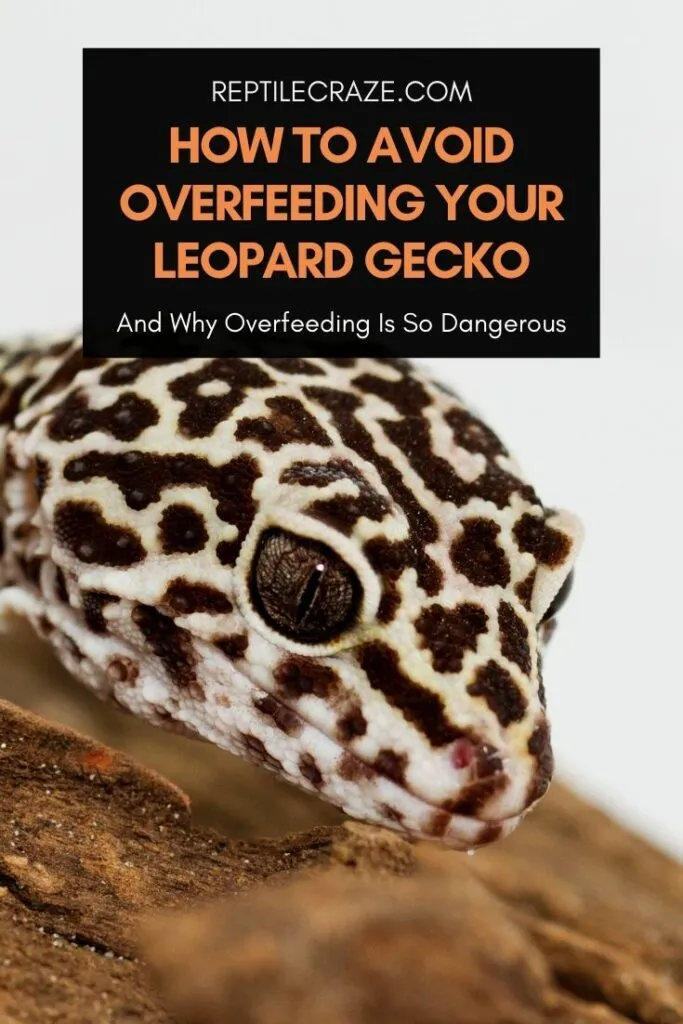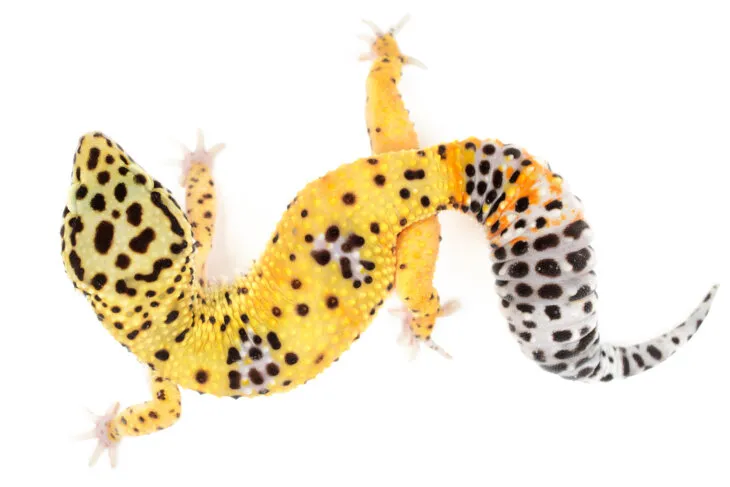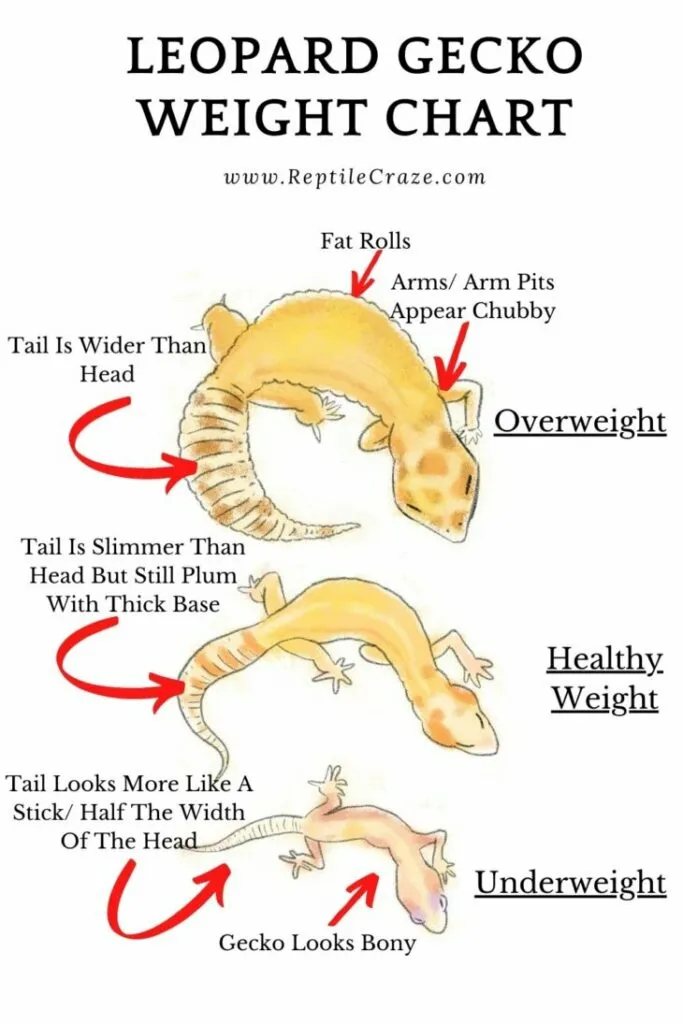
When you first get a Leopard Gecko (Eublepharis macularius), knowing what to feed them can be challenging. Leopard Geckos need a carefully planned, varied diet of insects to keep them healthy. If you underfeed them, there is a risk that you could stunt their growth or cause them to suffer nutrient deficiencies. But, can you overfeed Leopard Geckos?
It is possible to overfeed a Leopard Gecko, but less easy to do than with some other reptiles as they don’t tend to overeat so readily. Feeding a Leopard Gecko too much
That’s the basic answer. But, how can you know if you have fed too much, or are causing your Leopard Gecko to put on excessive weight? What are the consequences of overfeeding your Leopard Gecko and how can you avoid them?
Table of Contents
Leopard Geckos Can Be Overfed And It Is Not Healthy
Unlike some lizards, Leopard Geckos are fairly good at stopping eating when they are full, and don’t tend to endlessly gorge themselves. However, this handy habit cannot be relied upon to manage healthy portion sizes for your pet.
This is because every Leopard Gecko is an individual, and some are more
For example, many Leopard Geckos eat far too many wax worms if given the opportunity. You can find out why in our article on why Leopard Geckos become addicted to wax worms.
Overfeeding can lead to obesity and improper development. It is also the cause of many health complications.
How To Tell If You Have Overfed Your Leopard Gecko
If you have overfed your Leopard Gecko, there may not be any immediate signs of this. Instead, you may notice long-term signs that indicate that you are chronically overfeeding your Leopard Gecko. We will discuss these in detail momentarily.
However, if you have given your Leopard Gecko far too much
- Regurgitation.
If your Leopard Gecko has eaten far too much, he may vomit.
- Lethargy.
In order to digestfood , your Leopard Gecko must rest his belly on a warm surface and rest. This is normal behavior, but if you notice your Leopard Gecko is inactive for much longer than usual, he may be struggling to digest a large meal.
- Upset stomach.
Eating too much can cause diarrhea or constipation. If you see diarrhea, ensure that you increase your Leopard Gecko’s hydration by providing water and humidity. If you see constipation, be mindful to monitor your Leopard Gecko for…
- Impaction.
Impaction occurs when a bolus offood becomes trapped in your Leopard Gecko’s gut and blocks it.Food builds up behind it, and the Leopard Gecko cannot pass stools. Signs include a swollen lump in the belly, constipation, loss of appetite, and lethargy. Impaction requires medical intervention.

What Happens If A Leopard Gecko Eats Too Much For A Long Time
If a Leopard Gecko eats too much
An obese Leopard Gecko will become lethargic. Organs such as the heart and liver will suffer stress and will not function as efficiently.
Hepatic Lipidosis (Fatty Liver Disease)
When fat begins to impact the function of the liver, obesity can trigger hepatic lipidosis. This is commonly called fatty liver disease.
As liver function is damaged, fat and protein can no longer be metabolized. When this happens, the Leopard Gecko will begin to lose weight, will become very lethargic, and yellow-green diarrhea may be seen. Veterinary treatment is essential.
How Often To Feed Leopard Geckos By Age
In order to avoid overfeeding, it is essential to know how to create a good base diet for your Leopard Gecko. Here’s how often you should be feeding your Leopard Gecko by age.
| Age of Leopard Gecko | Frequency of feeding |
| Baby 0-4 months | Every day |
| Juvenile 4-12 months | After 4 months of age, begin to punctuate the week with days off, until around 6 months, when they should eat every other day |
| Adult 12+ months | Every 2-3 days |
How Much To Feed Leopard Geckos By Age
It is difficult to prescribe exactly how much to feed a Leopard Gecko, as the amount can change depending on the foodstuff and the health status of the Leopard Gecko.
Babies and juveniles, gravid females, and Leopard Geckos recovering from sickness or injury should be offered more
Below, you can see a typical feeding schedule. This will give you a baseline of how much
Though the number of insects is often similar, portions are controlled by selecting appropriately-sized insects. The right size insect is easily swallowed and narrower than the space between your Leopard Gecko’s eyes.
How often you offer
| Age of Leopard Gecko | Approximately how many insects to feed | Example meal |
| Baby 0-4 months | 5-7 small insects | 3 small black soldier fly larvae + 3 small mealworms |
| Juvenile 4-12 months | 5-7 medium insects | 4 medium dubia roaches + 2 medium black soldier fly larvae |
| Adult 12+ months | 6 to 8 large insects | 5 large crickets + 3 large mealworms |
You can also do a quick test to see how satisfied your Leopard Gecko is with the portions that you are providing. Every now and then, use a different feeding technique.
The technique is to give your Leopard Gecko as many insects that they will eat within a ten-minute period. Do not try this with an appetizing treat such as wax worms. Instead, you should use staple feeders for this technique.
If your Leopard Gecko eats more or less than you have been planning for their meals, this may show that they want more or less
Healthy Diet Choices Are As Important As The Amount Of Food
The insects that you choose to feed to your Leopard Gecko all have very different nutritional values.
Sometimes, Leopard Geckos are overfed not because they are given an excessive number of insects but because the insects are very high in fat.
Take a look at the table below to compare nutritional information for common feeder insects for Leopard Geckos. Note that staple feeder insects such as crickets, mealworms, and dubia roaches are much lower in fat than treats such as wax worms.
| Wax Worms | Black Soldier Fly Larvae | Meal Worms | Dubia Roaches | Crickets | |
| Moisture | 62% | 64% | 66% | 65% | 73% |
| Protein | 14% | 17% | 18% | 21% | 18% |
| Fat | 18% | 11% | 10% | 9% | 6% |
| Fiber | 3% | 6% | 2% | 1% | 2% |
| Ca:P Ratio | 1:7 | 2.5:1* | 1:7 | 1:3 | 1:9 |
(BSF Larvae Ca:P ratio: Boykin et al., 2020)
As a result, a Leopard Gecko that is fed 6 waxworms will get much more fat and calories than a Leopard Gecko that is fed 6 crickets in a meal.
Therefore, you can also overfeed and cause obesity in your Leopard Gecko by feeding them an inappropriately fatty diet.
Find out more about the insects that you can choose to feed your Leopard Gecko by visiting our detailed guide on what Leopard Geckos can eat.
How To Know If You Are Feeding Leopard Geckos The Right Amount
Keeping a
You should weigh your Leopard Gecko every 2 weeks or so. You should also take measurements. This is especially if they are a baby or juvenile, as their healthy growth during this phase is essential.
If you find that your Leopard Gecko is gaining weight, losing weight, or not developing properly, you will know whether you are feeding too much, or not enough.
You can refer to your
All Leopard Geckos are individuals and could vary from the normal weight, while still being healthy. However, the table below is a good baseline guide for how big your Leopard Gecko should be by age.
Approximate Healthy Weight Of Leopard Geckos By Age
| Stage | Age | Weight | Body Length |
| Hatchling | 0 months | 2 – 4 grams newborn | 3 inches |
| Baby | 1 month | 15 – 25 grams | 4 – 5 inches |
| 2 – 3 months | 20 – 30 grams | 5 – 5.5 inches | |
| Juvenile | 4-5 months | 25 – 35 grams | 5.5 – 6 inches |
| 6 – 7 months | 30 – 40 grams | 6 – 6.5 inches | |
| 8- 9 months | 35 – 45 grams | 7 – 7.5 inches | |
| Adult | 10 – 12 months | 40 – 50 grams | 7.5 – 8 inches |
| 18 – 20 months | 60 – 90 grams | 8 – 12 inches |
Keep in mind that fully grown females reach around 7 to 8 inches, while males can reach 10 or even 12 inches long.
Because of this, it is likely that females may be on the smaller end of the ranges in this table, while males will be at the top end.
What Does A Leopard Gecko At A Healthy Weight Look Like?
Checking the body condition of your Leopard Gecko is also very important to determine whether you are overfeeding them. Unlike size and weight, judging body condition comes down to what you can see. A healthy Leopard Gecko will:
- Have bright eyes.
- Move around freely and easily.
- Have a tail with a thick base and gentle obtuse rounded shape that is not wider than its head.
Take a look at the diagram below to compare a healthy Leopard Gecko with an overweight and underweight Leopard Gecko. An overweight Leopard Gecko will:
- Have a very thick and wide tail that is the same width as its head or even more.
- Be lethargic and drag its belly when it moves.
- Have thick legs.
- Have fat rolls.
- Have bubbles of fat in the armpit area.

In the following video you can see some very clear examples of Leopard Geckos that have gained or lost excessive weight as a result of poor diet, as well as natural processes such as egg laying.
Should You Put Your Leopard Gecko On A Diet?
If you have determined that your Leopard Gecko is overweight, you may need to put them on a diet. But, you should be very cautious. Sudden changes in their
Also, you may misunderstand what is wrong with your Leopard Gecko and prescribe them the wrong diet. This can easily happen when hepatic lipidosis causes Leopard Geckos to lose weight rapidly.
Despite being obese, owners may try to feed them fatty wax worms to build their weight back up.
And, as we have identified above, your Leopard Gecko may deviate from the healthy weight and size, but still be a perfectly healthy individual.
For these reasons, we recommend that you consult a vet before trying to alter your pet’s body condition through diet.
How To Tell If Your Leopard Gecko Is Still Hungry
A sign that your Leopard Gecko is still hungry is that he is still seeking
However, just because your Leopard Gecko seems hungry doesn’t mean that he are underfed. As you can see from the diagram above, if your Leopard Gecko is underfed he will begin to lose weight. His tail will look narrower, and their legs skinny.
To find out more about how to tell if your Leopard Gecko is still hungry, check out our guide on how to tell your Leopard Gecko is eating enough.
- Enchi Ball Python: A Unique and Stunning Morph of Python regius - March 27, 2025
- Emerald Tree Monitor: The Enigmatic Green Guardian of the Rainforest - March 26, 2025
- The Egyptian Cobra (Naja haje): A Fascinating Serpent - March 25, 2025
